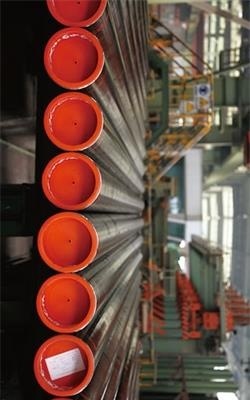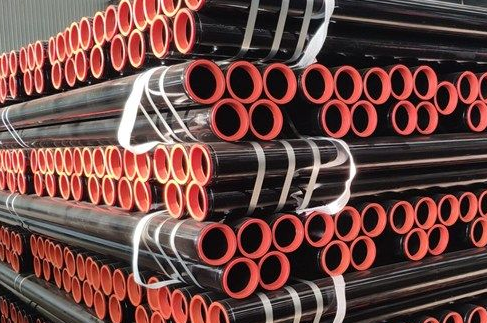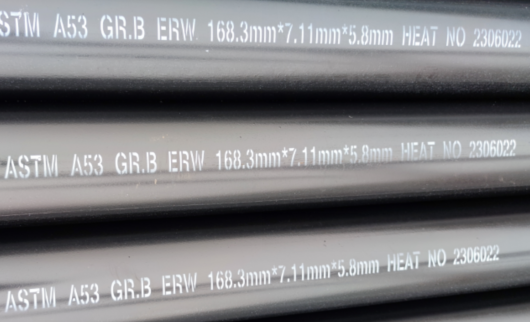

ASTM A53 - Standard specification for welded and seamless carbon steel pipe developed by the American Society for Testing and Materials (ASTM). The standard covers a variety of pipe sizes and thicknesses and applies to piping systems used to transport gases, liquids and other fluids.
ASTM A53 pipe is intended for mechanical and pressure applications and is also acceptable for ordinary uses in steam, water, gas and air lines.
½” – 12” some limitations dependent upon grade. Sizes up to 26” OD are available on limited basis.
Standard Specification for Pipe, Steel, Black and Hot-Dipped, Zinc-Coated, Welded and Seamless. This specification covers seamless and welded black and hot-dipped galvanized steel pipe.

The following types and grades of A53 pipe are covered within this specification:
ASTM A53 Galvanizing standard requirements:
ASTM A53 standard specification including hot dipped galvanized (zinc coated) requirements for ASTM A53 Grade B pipe.
Moreover, there are pipe internal and external galvanization. By the hot dip procedures, zinc thickness of any grade shall be complied to specification B6.
Zinc coating weight should be not less than 1.8 oz/ft2, 0.55 kg/m2, and each sample weight shall not be not less than 1.6 oz/ft2 0.49 kg/m2, meanwhile sample outside surface and inside surface weight shall not be less than 1.3 oz/ft2 0.40 kg/m2.
ASTM A53 Applications:
1 Architecture: maximum pipeline under more groundwater extraction when towers, boilers, hot water conveyance and so on.
2 Machining, bearing sets, processing machinery and other accessories.
3 Electrical class: gas distribution, water power fluid conduit.
4 Anti-static tubes wind power plants.
MECHANICAL PROPERTIES – TENSILE REQUIREMENTS
| Seamless and ERW | Grade A | Grade B |
| Tensile Strength, min, psi | 48,000 ( ≥330 Mpa) | 60,000 ( ≥415 Mpa) |
| Yield Strength, min, psi | 30,000 ( ≥205 Mpa) | 35,000 ( ≥240 Mpa) |
|
Elongation (%) |
≥35 |
≥30 |
Key difference:
Grade B has higher strength (yield strength ≥ 240MPa) and is suitable for higher pressure pipeline systems.
Grade A has better plasticity (elongation ≥ 35%) and is more suitable for cold bending, winding and other forming processes.
CHEMICAL REQUIREMENTS FOR ASTM A53:
| Seamless and ERW | C max % | Mn max % | P max % | S max % |
| Grade A | 0.25 | 0.95 | 0.05 | 0.045 |
| Grade B | 0.30 | 1.20 | 0.05 | 0.045 |
| Type |
Carbon
max. % |
Manganese max. % |
Phosphorous max. % |
Sulfur max. % |
Copper max. % |
Nickel max. % |
Chromium max. % |
Molybdenum max. % |
||||||||
|
Grade A |
Grade B |
Grade A |
Grade B |
Grade A |
Grade B |
Grade A |
Grade B |
Grade A |
Grade B |
Grade A |
Grade B |
Grade A |
Grade B |
Grade A |
Grade B |
|
|
Type S (seamless) |
0.25 | 0.30 | 0.95 | 1.2 | 0.05 | 0.05 | 0.045 | 0.045 |
0.40 |
0.40 |
0.40 |
0.40 |
0.15 |
0.15 |
0.08 |
0.08 |
|
Type E (electric-resistance welded) |
0.25 | 0.30 | 0.95 | 1.2 |
0.05 |
0.05 | 0.045 | 0.045 |
0.40 |
0.40 |
0.40 |
0.40 |
0.15 |
0.15 |
0.08 |
0.08 |
|
Type F (furnace-welded pipe) |
0.30 | / | 1.2 | / | 0.05 | / |
0.045 |
/ |
0.40 |
/ |
0.40 |
/ |
0.15 |
/ |
0.08 |
/ |
Comparison of typical application scenarios:
A53 GR.A: Commonly used in construction, low-pressure (≤5MPa) fluid transportation fields, such as plumbing pipes, building structure support, and low-pressure steam systems.
A53 GR.B: Commonly used in petroleum, chemical industry, machinery manufacturing, medium and high pressure fluid transportation (≤15MPa), such as oil and gas pipelines, high pressure boiler auxiliary pipelines, and mechanical structural parts.

Key difference:
Grade A is suitable for low pressure, non-critical systems, such as building plumbing and air conditioning pipelines.
Grade B is suitable for medium and high pressure industrial pipelines, such as petroleum and chemical industries.
How to choose the right grade?
Low-pressure fluid, cold bending/winding requirements → Grade A (economical, good forming performance)
Medium- and high-pressure fluid, structural load-bearing requirements → Grade B (higher strength, good pressure resistance)
Grade B of ASTM A53 is a common choice for medium- and high-pressure pipelines, while Grade A is suitable for low-pressure, cold-bending applications. Choosing the right grade according to specific working conditions can optimize cost and performance.
Comparison of A53 pipe with other standards:
ASTM A106: High-temperature and high-pressure seamless pipe (≤650°C), produced only by seamless methods, suitable for steam/oil and gas pipeline systems.
API 5L: Long-distance oil and gas pipelines, suitable for more stringent pressure resistance & corrosion resistance requirements.
Manufacturing process of ASTM A53 steel pipe:
The production process of ASTM A53 steel pipe varies according to its type (seamless pipe or welded pipe) and specific manufacturing method (such as hot rolling, cold drawing, resistance welding, etc.).
1. Seamless steel pipe production process
ASTM A53 seamless steel pipe is divided into two processes: hot rolling and cold drawing. The specific process is as follows:
(1) Hot rolled seamless pipe production process
Pipe blank preparation: Select carbon steel billet that meets the standard (such as 20# steel corresponding to A53-B grade).
Heating: Heat to 1100°C~1250°C in a ring furnace or walking furnace.
Piercing: Use a cross-rolling piercing machine or a pressure piercing machine to pierce the solid billet into a hollow rough tube.
Rolling: Extend and deform through three-roll cross-rolling or continuous rolling mill.
Sizing: Adjust the outer diameter and wall thickness to standard size.
Cooling: Air cooling or controlled cooling.
Straightening: Eliminate bending deformation.
Detection: Water pressure test, ultrasonic flaw detection (UT), etc.
Warehousing: Marking, packaging and storage.
Features:
High production efficiency, suitable for large-diameter thick-walled pipes.
The surface roughness is relatively high, and the wall thickness uniformity is slightly inferior to that of cold-drawn tubes.
(2) Cold-drawn seamless pipe production process
Tube billet heating and perforation (same as hot rolling).
Heading: convenient for cold drawing machine clamping.
Annealing: eliminate internal stress and improve plasticity.
Pickling: remove oxide scale.
Cold drawing: multi-pass drawing to target size (outer diameter can be accurate to ±0.1mm).
Heat treatment: normalizing or tempering to adjust performance.
Inspection and storage (same as hot rolling).
Features:
High dimensional accuracy and good surface finish.
Suitable for small-diameter thin-walled tubes (such as tubes for hydraulic cylinders).
2. Welded steel pipe production process
ASTM A53 welded pipes mainly include electric resistance welding (ERW) and submerged arc welding (SAW/LSAW):
(1) High-frequency electric resistance welding (ERW Pipe) process
Steel strip pretreatment: uncoiling, leveling, and trimming.
Forming: The steel strip is gradually rolled into a tube shape by multiple sets of rollers, and the edges are aligned for welding.
High frequency welding (HFW): The edges are heated by high frequency current and pressurized to fuse to form a continuous weld.
Heat treatment of the weld: Tempering at at least 540°C to eliminate martensite.
Sizing and straightening: Ensure dimensional accuracy.
Inspection: Eddy current testing (ET), water pressure test, etc.
Features:
High production efficiency and low cost.
Suitable for small and medium diameter pipes (such as galvanized pipes for construction).
(2) Submerged arc welding (SAW/LSAW Pipe) process
Steel plate milling: Double-sided milling of the steel plate edge to ensure the groove shape and dimensional accuracy.
Pre-bending: The steel plate edge is formed into the required curvature by a pre-bending machine to facilitate subsequent forming.
JCOE forming: Gradually pressed into a "J-C-O" shape and then closed into a tube blank.
Pre-welding: Gas shielded welding (MAG) is used to temporarily fix the joint.
Internal and external submerged arc welding: Use a multi-wire submerged arc welding machine to weld the weld on both sides to ensure high strength.
Diameter expansion: Improve stress distribution.
Detection: X-ray (RT), ultrasonic (UT)
Features:
Applicable to large-diameter thick-walled pipes (such as oil and gas pipelines).
The weld strength is high, but the cost is high.
ERW welded pipe (small diameter): high-frequency resistance welding, suitable for construction and mechanical structures.
SAW/LSAW welded pipe (large diameter): submerged arc welding, suitable for oil and gas transportation, high-pressure pipelines.
ASTM A53 steel pipe quality inspection:
Non-destructive testing (NDT):
Ultrasonic flaw detection (UT): Detect internal defects of welds and parent materials.
X-ray detection (RT): Check for defects such as pores and lack of fusion inside the weld.
Magnetic particle testing (MT): Used for pipe end crack detection.
Hydrostatic test: Test the pressure bearing capacity of each steel pipe to ensure no leakage
Strict quality control (such as flaw detection, hydrostatic test) and surface treatment (galvanizing, coating) ensure that it meets the ASTM A53 standard and meets the needs of different industries.
Bending requirements:
For pipe NPS 2(DN50) and under, a sufficient length of pipe shall be capable of being bent cold through 90°around a cylindrical mandrel, the diameter of which is twelve times the outside diameter of the pipe, without development cracks at any portion and without opening the weld.
When ordered for close coilling, the pipe shall stand being bent cold through 180°around a cylindrical mandrel, the diameter of which is eight times the outside diameter of the pipe, without failure.
Double extra strong pipe over NPS 1 1/4(DN 32) need not be subjected to the bend test.
Flattening test:
The flattening test shall be made on pipe over NPS 2(DN 50) with all thickness extra strong and lighter.
For seamless pipe, a test specimen at least 2 1/2 in.(60mm) in length shall be flattened cold between parallel plates in two steps. During the first step, which is a test for ductility, no cracks or breaks on the inside, outside, or end surfaces. During the second step, which is test for soundness, the flattening shall be continued until the test specimen breaks or the opposite sides of the pipe meet. Evidence of laminated or unsound material that is revealed during the entire flattening test shall be cause for rejection.
For electric resistance welded pipe, a test specimen at leat 4in. (100mm) in length shall be flattened cold between parallel plates in three steps, with the weld located either 0°or 90°from the line of direction of force. During the first step, which is a test for ductility of the weld, no cracks or breaks on the inside or outside surfaces at the weld shall occur until the distance between the plates is less then two thirds of the specified diameter of the pipe. as a second step, the flattening shall be continued as a test for ductility away from the weld. During the second step, no cracks or breaks on the inside or outside surfaces away from the weld. During the third step, which is test for soundness, the flattening shall be continued until the test specimen breaks or the opposite walls of the pipe meet. Evidence of laminated or unsound material or of incomplete weld that is revealed by the flattening test shall be cause of rejection.
